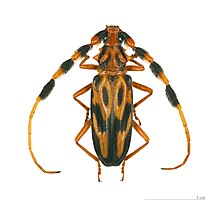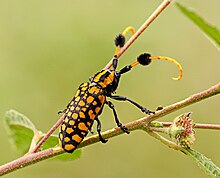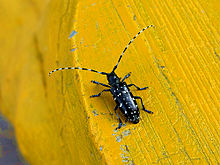Longhorn beetle
| Cerambycidae Temporal range: Late Jurassic–Recent
PreꞒ
Ꞓ
O
S
D
C
P
T
J
K
Pg
N
| |
|---|---|

| |
| Batus barbicornis | |
| Scientific classification | |
| Kingdom: | Animalia |
| Phylum: | Arthropoda |
| Class: | Insecta |
| Order: | Coleoptera |
| Superfamily: | Chrysomeloidea |
| Family: | Cerambycidae Latreille, 1802 [1] |
| Subfamilies | |
|
Eight; see text | |
The longhorn beetles (Cerambycidae), also known as long-horned or longicorns, are a large family of beetles, with over 35,000 species described,[2] slightly more than half from the Eastern Hemisphere. Most species are characterized by extremely long antennae, which are often as long as or longer than the beetle's body. In various members of the family, however, the antennae are quite short (e.g., Neandra brunnea) and such species can be difficult to distinguish from related beetle families such as the Chrysomelidae. The scientific name of this beetle family goes back to a figure from Greek mythology: after an argument with nymphs, the shepherd Cerambus was transformed into a large beetle with horns.
Description[]
Other than the antennal length, the most consistently distinctive feature of the family is that the antennal sockets are located on low tubercles on the face; other beetles with long antennae lack these tubercles, and cerambycids with short antennae still possess them. They otherwise vary greatly in size, shape, sculpture, and coloration. A number of species mimic ants, bees, and wasps, though a majority of species are cryptically colored. The titan beetle (Titanus giganteus) from northeastern South America is often considered the largest insect (though not the heaviest, and not the longest including legs), with a maximum known body length of just over 16.7 cm (6.6 in).[3]
Biology[]
All known longhorn beetle larvae feed on plant tissue such as stems, trunks, or roots of both herbaceous and woody plants, often in injured or weak trees.[4] A few species are serious pests. The larvae, called roundheaded borers, bore into wood, where they can cause extensive damage to either living trees or untreated lumber (or, occasionally, to wood in buildings; the old-house borer, Hylotrupes bajulus, is a particular problem indoors).
Predators[]
Parasitoids[]
In North America native Cerambycids are widely the victims of . O. mellipes may be useful in controlling a forestry pest in this same family, Anoplophora glabripennis, that is invasive in North America. ( is a genus of parasitoid wasps in the Doryctinae.)[5]
Classification[]

As with many large families, different authorities have tended to recognize many different subfamilies, or sometimes split subfamilies off as separate families entirely (e.g., Disteniidae, Oxypeltidae, and Vesperidae);[6] there is thus some instability and controversy regarding the constituency of the Cerambycidae.[7] There are few truly defining features for the group as a whole, at least as adults, as there are occasional species or species groups which may lack any given feature; the family and its closest relatives, therefore, constitute a taxonomically difficult group, and relationships of the various lineages are still poorly understood.[8] The oldest member of the family is Cerambycinus from the Late Jurassic Solnhofen Limestone of Germany, with other Mesozoic fossils including and from the Aptian aged Yixian Formation of China, and from the early Late Cretaceous (Cenomanian) aged Burmese amber, belonging to the subfamily Subfamily Prioninae, Tribe Meroscelisini.
Subfamilies[]
The eight subfamilies are:[9][10]
- Cerambycinae Latreille, 1802
- Dorcasominae Lacordaire, 1869 (including former Apatophyseinae Lacordaire, 1869)
- Lamiinae Latreille, 1825
- Lepturinae Latreille, 1802
- Necydalinae Latreille, 1825
- Parandrinae Blanchard, 1845
- Prioninae Latreille, 1802
- Spondylidinae Audinet-Serville, 1832 (including former Aseminae Thomson, 1860)
Notable genera and species[]

- Acrocinus longimanus – harlequin beetle, a large species where the male has very long front legs
- Anoplophora chinensis – citrus long-horned beetle, a major pest
- Anoplophora glabripennis – Asian long-horned beetle, an invasive pest species
- Aridaeus thoracicus – tiger longicorn (Australia)
- Cacosceles newmannii - Southern African longhorn beetle that is a surgacane pest
- Desmocerus californicus dimorphus – valley elderberry longhorn beetle, a threatened subspecies from California
- Moneilema – cactus longhorn beetles, which are flightless
- Onychocerus albitarsis – the only known beetle with a venomous sting
- Petrognatha gigas – giant African longhorn beetle
- Prionoplus reticularis – huhu beetle, the heaviest beetle in New Zealand
- Rosalia alpina – Rosalia longhorn beetle, a threatened European species
- Tetraopes tetrophthalmus – red milkweed beetle, a toxic species with aposematic colors
- Tetropium fuscum – brown spruce longhorn beetle, an invasive pest species
- Titanus giganteus – titan beetle, one of the largest beetles in the world
See also[]
References[]
- ^ "Cerambycidae Latreille, 1802". Integrated Taxonomic Information System. Retrieved June 6, 2011.
- ^ "The first long-horned beetle giving birth to live young discovered in Borneo". Science Daily. 11 May 2016. Retrieved 14 June 2021.
- ^ Max Barclay (2010). "Titanus giganteus Linnaeus (1771)". Natural History Museum. Retrieved June 6, 2011.
- ^ Kariyanna B; Mohan M & Rajeev Gupta (2017). "Biology, ecology and significance of longhorn beetles (Coleoptera: Cerambycidae)". Journal of Entomology and Zoology Studies. 5: 1207–1212. ISSN 2320-7078.
- ^ "PPQ Scientists Evaluate Wasp's Ability to Detect and Attack the Asian Longhorned Beetle". PPQ (Plant Protection and Quarantine). USDA APHIS. Retrieved 2021-09-07.
- ^ Sergio Antonio Vanin & Sergio Ide (2002). "Classificação comentada de Coleoptera" [An annotated classification of the Coleoptera]. In C. Costa; S. A. Vanin; J. M. Lobo & A. Melic (eds.). Proyecto de Red Iberoamericana de Biogeografía y Entomología Sistemática PrIBES 2002 (PDF). Monografias Tercer Milenio (M3M) (in Portuguese). 3. pp. 193–206. ISBN 84-922495-8-7.
- ^ Miguel A. Monné (2006). "Catalogue of the Cerambycidae (Coleoptera) of the Neotropical Region. Part III. Subfamilies Parandrinae, Prioninae, Anoplodermatinae, Aseminae, Spondylidinae, Lepturinae, Oxypeltinae, and addenda to the Cerambycinae and Lamiinae" (PDF excerpt). Zootaxa. 1212: 1–244. ISBN 1-877407-96-8.
- ^ Arnett, et al. (2002). American Beetles, Vol. 2. CRC Press, 861 pp.
- ^ Patrice Bouchard; Yves Bousquet; Anthony E. Davies; Miguel A. Alonso-Zarazaga; John F. Lawrence; Chris H. C. Lyal; Alfred F. Newton; Chris A. M. Reid; Michael Schmitt; S. Adam Ślipiński; Andrew B. T. Smith (2010). "Family-group names in Coleoptera (Insecta)". ZooKeys. 88: 1–972. doi:10.3897/zookeys.88.807. PMC 3088472. PMID 21594053. Archived from the original on 2011-07-21.
- ^ Švácha, P.; Lawrence, J. (2014). "2.4. Cerambycidae Latreille, 1802" (PDF). In Leschen, R.A.B.; Beutel, R.G. (eds.). Handbook of Zoology, Arthropoda: Insecta; Coleoptera, Beetles, Volume 3: Morphology and Systematics (Phytophaga). Berlin/Boston: Walter de Gruyter. pp. 77–177. doi:10.1515/9783110274462.77. ISBN 978-3-11-027446-2.
Further reading[]
- Monné, Miguel A. & Hovore, Frank T. (2005) Electronic Checklist of the Cerambycidae of the Western Hemisphere. PDF Cerambycids.com
External links[]
| Wikimedia Commons has media related to Cerambycidae. |
| Wikispecies has information related to Cerambycidae. |
- Gallery Photo gallery of worldwide long-horned beetles
- Photo gallery "Longhorn beetles (Cerambycidae) of the West Palaearctic Region"
- CDFA Cerambycidae of the New World
- Cerambycidae of French Guiana
- National Museu, Rio, Brazil Holotype images
- Iberodorcadion Coleoptera, Cerambycidae, Dorcadion - RedIRIS
- VIDEOS - Longicornes (Dorcadion, Cerambycidae, Coleoptera)
- Cerambycidae of Borneo pdf
- BugGuide.net - Longhorned Beetles (Cerambycidae)
- Anoplophora chinensis, citrus longhorned beetle on the University of Florida / Institute of Food and Agricultural Sciences Featured Creatures website
- Coleoptera: Cerambycidae, University of Florida, Dept. of Entomology and Nematology
- Wood-boring beetles of the World
- [1]
- Cerambycidae
- Beetle families
- Insect families
- Polyphaga families


